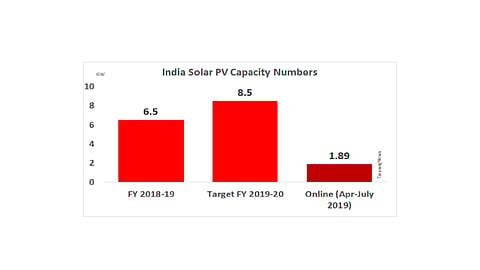

Till the end of July 2019, India's total grid-interactive solar power capacity was reported to be a little over 30 GW coming from 27.93 GW of ground mounted PV and 2,141 MW of rooftop solar, according to the Indian Ministry of New and Renewable Energy (MNRE). The start of the financial year from April 2019 to July 2019 saw 1,546 MW of total capacity coming online in ground mounted plants and 344.68 MW of rooftop solar, taking the total to 1.89 GW.
Out of the total 30 GW operating, Karnataka leads the race among all Indian states with more than 6.3 GW installed, followed by Rajasthan with 3.7 GW, Telangana with 3.62 GW, Andhra Pradesh with 3.31 GW and Tamil Nadu with 2.81 GW as the top five states.
However, in the India's leading solar state Karnataka, the state administration has reportedly halted all solar tender and auction activity for the time being since it believes the state has enough solar power to meet its renewable purchase obligation till March 2022 (see No More Solar Bids For Karnataka).
India's official solar power capacity target for FY 2019-2020 is 7.5 GW for large scale solar and 1 GW for rooftop PV. The cumulative installed number of over 30 GW contributes to 81.30 GW of total renewable energy capacity of the country till July 2019.
In FY 2018-19, MNRE said India grid-connected 6.5 GW of solar power capacity taking the cumulative to 28.78 GW (see India Installed Only 6.5 GW Solar In FY 2018-19).
However, independent market research firm Mercom India Research's India Solar Project Tracker shows the country had close to 31.5 GW of total installed capacity till the end of June 2019, representing 8.73% of all capacity installed.
Referring to the Central Electricity Authority (CEA) data, Mercom reports in Q2/2019 of calendar year (CY) 2019, solar power generation increased by 29% YoY and 7% QoQ to 12,277 million units (MU). But compared to solar power generation in H1/2018, there was a decline of 32% in the growth rate of power generated by this technology.
With only three financial years left till March 2022 when India is aiming to have 100 GW of solar PV capacity, comprising 60 GW of ground mounted and 40 GW of rooftop solar, the installed number of 30 GW is quite far off from the target. While time is very tight, there are even huge obstacles in the way – there is reduced investor interest in the wake of the country's safeguard duty imposition on imported PV products as well as renewable energy generators not being able to get their dues cleared from electricity distribution companies (discoms). According to Mercom, CEA data show that distribution companies in India owe a total of INR 30.12 billion ($420 million) to renewable energy projects representing 5,982 MW capacity.
The government has asked CEA for details about the pending amounts of individual discoms in order to bring in transparency and identify offenders.
.png?w=50&fm=png)